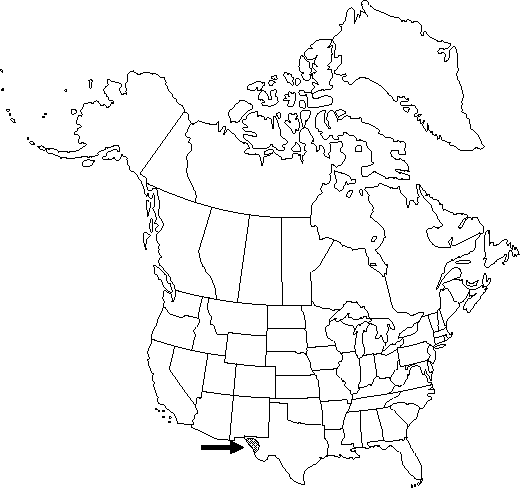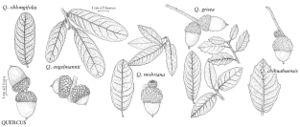Quercus chihuahuensis
Mem. Natl. Acad. Sci. 20: 85. 1924.
Shrubs or trees, deciduous, to 10 m. Bark gray, furrowed, checkered, or scaly. Twigs gray, 2-3 (-4) mm diam., densely tomentose. Buds reddish-brown, broadly ovoid, distally rounded, 2-2.5 mm, densely yellowish pubescent; scales gray-puberulent; stipules persistent, 1-4, subulate, pubescent, at base of terminal buds. Leaves: petiole 3-5 (-8) mm. Leaf-blade elliptic or oblong to ovate or obovate, (25-) 40-50 (-85) × (18-) 20-30 (-50) mm, base rounded or shallowly cordate, margins entire or toothed to sublobate, secondary-veins 8 to 10 on each side, somewhat branching, apex broadly rounded to acute; surfaces abaxially yellowish or grayish, densely stellate with velvety hairs, adaxially green, sparsely soft-pubescent with prominent, spreading, stellate hairs, felty to touch, secondary-veins somewhat prominent on both surfaces, even under dense tomentum. Acorns 1-3 on tomentose peduncle 15-35 (-60) mm; cup hemispheric, 7-10 mm deep × 10-15 mm wide, enclosing 1/2 nut, scales proximally thickened, distally appressed, densely gray-puberulent, tips reddish, ultimately glabrate; nut ovoid, 14-18 × 10-12 mm, puberulent, eventually glabrate. Cotyledons connate.
Phenology: Flowering spring.
Habitat: Oak and pinyon-juniper woodlands, grassy hills, sometimes extending into dry thorn scrub and bursera woodland (Mexico)
Elevation: 400-2000 m
Distribution

Tex., Mexico (Chihuahua), Mexico (Sonora), Mexico (Zacatecas), Mexico (and San Luis Potosí)
Discussion
Quercus chihuahuensis is a distinctive species throughout its range, mostly in dry montane western Mexico; it occurs in the United States only as putative hybrids with Q. grisea (the Eagle and Quitman mountains) and Q. arizonica (Hueco Tanks) in Texas.
Selected References
None.
